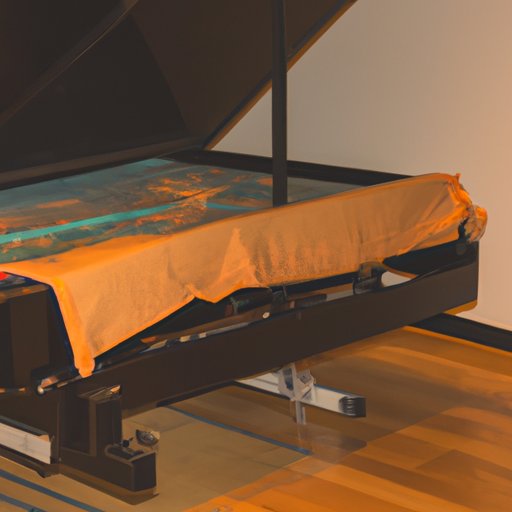
Introduction
Moving a piano is no easy task. Pianos are delicate, heavy, and valuable instruments that require special care during transport. Many factors can make moving a piano difficult and stressful, including the size and weight of the instrument, the distance it needs to be moved, and the route it needs to travel. The purpose of this article is to provide readers with tips and strategies for moving their piano safely and securely.
10 Tips for Moving Your Piano Safely and Securely
Proper preparation is key to a successful piano move. Here are ten tips to help you move your piano safely and securely:
- Measure the piano before moving it.
- Remove all music, books, and other items from the piano.
- Cover the piano with moving blankets or pads to protect it from scratches and scuffs.
- Secure the lid or cover to prevent it from opening during transport.
- Use a dolly or piano skid board to transport the piano.
- Secure the piano to the dolly or skid board with straps.
- Move the piano slowly and carefully, avoiding sudden jerks or movements.
- Use a ramp or lift to load the piano onto the truck.
- Secure the piano in the truck with straps or ropes to prevent it from shifting during transport.
- Unload the piano slowly and carefully, using a ramp or lift if necessary.
Piano Moving 101: The Essential Guide for Beginners
If you’re new to moving a piano, here’s a quick guide to get you started:
The first step in moving a piano is to determine the best route to take. Measure the piano, the hallways, and the doorways to ensure that the piano will fit through all the spaces it needs to travel. Once you have a plan in place, gather the necessary equipment, including a dolly or piano skid board, furniture pads or moving blankets, straps or ropes, and a truck.
When transporting the piano, make sure to keep it upright at all times. Tipping the piano on its side or back can cause damage to the instrument’s internal components. Use the dolly or skid board to transport the piano, and make sure to secure it with straps or ropes to prevent it from tipping over during transport.
If you’re moving the piano a long distance, it’s a good idea to hire a professional piano mover. Professional piano movers have the equipment and expertise needed to safely transport pianos over long distances.
Avoid These Common Mistakes When Moving Your Piano
Here are some of the most common mistakes piano owners make when moving their instrument:
- Not measuring the piano beforehand
- Not using the right equipment
- Not securing the piano properly during the move
- Not protecting the piano with moving blankets or pads
- Trying to move the piano alone or without help
The 5-Step Process for Moving Your Piano from Point A to Point B
Here’s a simple, step-by-step process for moving your piano:
- Prepare the piano for the move by measuring it, removing all items from inside the piano, and covering it with moving blankets or pads.
- Secure the lid or cover to prevent it from opening during transport.
- Use a dolly or piano skid board to transport the piano to the truck.
- Secure the piano in the truck with straps or ropes to prevent it from shifting during transport.
- Unload the piano slowly and carefully, using a ramp or lift if necessary, and transport it to its new location.
How to Move a Piano Without Damaging Your Floors
Moving a piano can cause damage to your floors unless you take the proper precautions. Here are some methods for moving a piano without causing damage to your floors:
- Use furniture pads or moving blankets to create a barrier between the piano and the floor.
- Lay down protective coverings, such as cardboard or plastic, on the floor underneath the piano’s path.
- Use proper lifting techniques to minimize the pressure on the piano’s legs and reduce the risk of damage to your floors.
The Dos and Don’ts of Moving Your Piano
Here are some best practices for moving your piano:
- Do hire a professional piano mover if you’re moving your piano long distance or if you’re unsure how to move it safely.
- Do stay organized throughout the move by creating a checklist and marking off tasks as they’re completed.
- Do use the proper equipment, such as a dolly or piano skid board, to transport the piano.
- Don’t lift the piano by its legs, as this can cause damage to the instrument’s internal components.
- Don’t try to move the piano alone or without help.
Why Hiring a Professional Piano Mover is the Best Option
While it’s possible to move a piano yourself, hiring a professional piano mover is the best option for several reasons:
- Professional piano movers have the specialized equipment needed to move pianos safely, including skid boards, ramps, and lifts.
- Professional piano movers have the expertise required to transport pianos over long distances without causing damage to the instrument’s internal components.
- Professional piano movers can provide you with peace of mind, knowing that your piano is being handled by experts who know how to move it safely and securely.
Conclusion
Moving a piano can be a difficult and stressful task. However, with these tips and strategies, you can move your piano safely and securely. Remember to measure your piano before moving it, cover it with moving blankets or pads, use the proper equipment, and avoid lifting the piano by its legs. If you’re unsure how to move your piano safely or if you’re moving it a long distance, consider hiring a professional piano mover.




